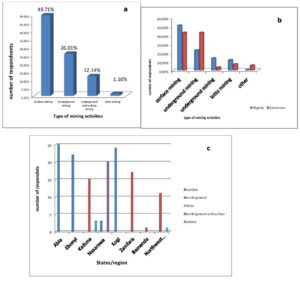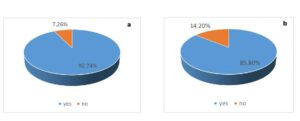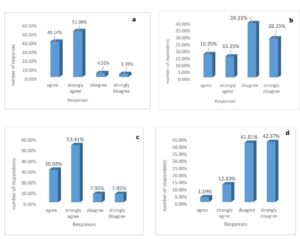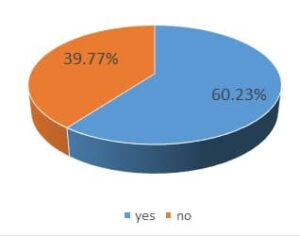Introduction
Loss of countryside to mining activities and mineral exploration is a long-lasting phenomenon that began in the late 1960s during the industrial revolution in Nigeria, and surrounding countries. However, climate change and the ability to see our planet from space, led to an enhanced regard of the vulnerability of the environment and the quest for its sustainability. By the 1970s an environmental revolution, with conservation at its core, was in full swing, highlighted by the pioneering 1972 United Nations Conference on the Human Environment held in Stockholm (Burek and Prosser, 2008). This was followed by the Earth Summit held in Rio in 1992, which placed the environment, through its role in achieving sustainable development, on the global political and social agenda (Burek and Prosser, 2008). Natural disasters and climate change constantly remind us of the need to harness natural resources with sustainability and conservation of our environment in mind. Three types of environmental impacts can occur as a result of mining activities. These include changes in the natural topography resulting in restrictions in how the land can be used for other purposes, hydro-geological conditions with consequences for both groundwater and surface water and changes in the geotechnical conditions of the rock (Gowtham and Naga, 2016).
In Nigeria, the most commonly discussed environmental impacts have been on the oil producing region of the Niger-Delta where agricultural, surface and underground water resources have been badly affected. However, artisanal and illegal mining of solid minerals in other parts of the country immensely affect the environment. Most of the artisanal and illegal miners (men, women and children) are poor rural dwellers, operating without legal mining title. Their activities include mining of gemstones like tourmaline, beryl, amethyst, aquamarine, garnet and precious minerals like diamond and gold. Other minerals widely mined are columbite, tantalite, copper, lead, zinc and cassiterite. Mining of river sands, digging of burrow pits, removal of topsoil, sand and laterite for building purposes are also carried out. Other activities include removal of vegetation and cleaning of dams to produce dam sands. This array of activities leads to uncoordinated and unregulated mining which usually results in haphazard extraction of the minerals and eventual destruction of the environment, generating huge socio-political and socio-economic concerns. Evidence of such destruction include soil erosion, changes in topography, water pollution and dumps of overburden material. The resultant effects of abandoned pits and other mining sites that become flooded during the rainy season pose health dangers to citizens. All these impact negatively on, and degrade the environment.
In this paper, mining communities and sites were visited, questionnaires were administered and respondents were interviewed. Two countries were selected, Nigeria and Cameroon. The six states Abia and Ebonyi (South East), Nasarawa and Kogi (North Central) and Kaduna and Zamfara (North West) were visited. In each State, at least two mines or mining communities were sampled and questionnaires administered. Only two communities (Bamenda and North West Cameroon) were visited and sampled in Cameroon. The aim of this research was to determine the geopolitical concerns arising from artisanal mining activities in both countries.
- To identify mining activities in the study area.
- To investigate the benefits and cost of mining activities on the study area
- Determine the nature and extent of geopolitical concerns related to mining in the study area
A justification for this study is that there have been complaints about mining activities that resulted to crises in many places across the study areas.
Literature review
Issues in the literature centre on the social contract for mining and corporate social responsibility (CSR). Mining and geopolitics are critical aspects that have attracted the attention of the World Economic Forum (WEF). The WEF plays a vital role in helping governments, companies, civil society and communities harness the maximum potential value of mining (World Economic Forum, 2016). The WEF has developed the Responsible Mineral Development Initiative (RMDI) which is a tool designed to improve the dialogue between stakeholders and key decision-makers in each country by fostering understanding of each stakeholder’s expectations of the value created by mining and identifying areas of misalignment (World Economic Forum, 2016). The dialogue facilitated through RMDI could create discussion around whether governments should address greater risks as a tool to keep the sector operational amidst geopolitical disruption.
In terms of corporate social responsibility, the WEF is of the opinion that creating real benefits for communities near mine sites will be key for successful new projects in obtaining the ‘license to operate’ from local communities, which has been a challenge for the mining industry in recent years (World Economic Forum, 2019). This has resulted in the rejection of many proposed projects where operations have been disrupted by protests.
O'Rourke (2012) examined the risks that mining companies face from both national governments and local communities. Such risks also stem from local governments, local and international NGOs, community groups, local competitors and other groups. However, it is important for government to intervene in a way called “creeping expropriation” rather than confiscation of assets by the community. This refers to State conduct that substantially deprives a foreign investor of the use or benefit of their investments, even though the formal legal title may continue to vest with the investor. Such expropriation could take the form of the imposition of a punitive tax regime that is applied selectively against the foreign enterprise, but is not applied to local companies. Indeed, the application of taxes and royalties in the mining sector has become a major issue for companies.
As an example, Yeboah (2008) examined the environmental and health impacts of Anglogold Ashanti’s mining activities on the people of Obuasi and other surrounding communities in Ghana by administering a questionnaire. This research revealed that mining activities resulted in land degradation leading to limited land being available for local food production and other agricultural purposes in the Obuasi municipality. Pollution also affected mainly water resources of major streams in the area. Air and noise pollution were also evident in the area. The combined effects of these environmental problems culminated in health problems with high prevalence of diseases such as malaria, respiratory tract infections and skin diseases
Frederiksen (2019) used a “political settlements” approach to examine the political effects of corporate social responsibility (CSR) in developing countries (Zambia, Ghana and Peru). Forty-seven confidential semi-structured interviews were conducted in Zambia (240 interviewees across all countries). The respondents included actors from industry bodies, mining companies, government and regulatory agencies and civil society. Results from the study showed that within the context of exclusionary political settlements, the practices of mining companies can reduce the potential for change and inclusive development. CSR spending was, in many cases, aimed at maintaining the status quo. Seeking to reduce risk to investments and produce operational stability in a context of considerable economic and environmental upheaval, CSR practices do little to challenge, and can work to entrench, clientalist political settlements.
Method
The study adopted primary sources of data through the administration of questionnaires, desk study and report writing. A total of 179 respondents were sampled from the two countries, 147 from Nigeria and 32 from the English-speaking areas in Cameroon. In Nigeria, six states that are engaged in mining were sampled. These include; Abia, Ebonyi, Kaduna, Kogi, Nasarawa and Zamfara. In Cameroon, Bamenda and North West Cameroon which are the English-speaking areas were sampled respectively. Descriptive statistics such as frequency tables, bar charts, pie charts and histograms were used as method of analysis in presenting the results.
Results
This section is divided into four sections, the first presenting the demographic characteristics of the respondents, and the second giving some information on the mining activities in the study area. The third section presents the benefits and costs of mining activities in the study area, while the fourth presents geopolitical concerns arising from mining activities in the study area.
Demographic characteristics of respondents
Ages of the respondents range from 15 to 60 and above (Table 1). The majority of the respondents are within the ages of 15–30 (about 52%) followed by 31–40 (about 34.1%). The information shows that close to 90% of the respondents are young.
Table 1: Age of respondents
Age | Freq/percent |
15-30 | 92 (52.3%) |
31-40 | 60(34.1%) |
40-60 | 14(7.10%) |
60 and above | 10(5.7%) |
Total | 176(100%) |
The majority of the respondents are males, at about 64.2%, while females are 35.8% (Table 2).
Table 2: Sex of respondents
Sex | Freq/percent |
Male | 113 (64.2%) |
Female | 63 (35.8%) |
The countries of origin of the respondents were Nigeria and Cameroon (Table 3). The majority of the respondents were sampled in Nigeria (82.1%), and 17.9% from Cameroon.
Table 3: Country of origin of the respondents
Country | Freq/percent |
Nigeria | 147 (82.1%) |
Cameroon | 32 (17.9%) |
Six states in Nigeria and two states/regions from Cameroon were sampled (Table 4). The states sampled in Nigeria are Abia, Ebonyi, Kaduna, Kogi, Nasarawa and Zamfara, while Bamenda and North West Cameroon were sampled in Cameroon. The majority of the respondents were from Nigeria; Kaduna and Abia had the highest number of respondents in Nigeria. North West Cameroon had the highest number of respondents in Cameroon. As against the total population of the regions sampled, the emphasis was on the areas were mining activities by the mining companies were taking place.
Table 4: State/region
State/Region | Freq/Percent |
Abia | 26 (14.6%) |
Ebonyi | 24 (13.5%) |
Kaduna | 25 (14.0%) |
Kogi | 24 (13.5) |
Nasarawa | 24 (13.4%) |
Zamfara | 24 (13.4%) |
Bamenda | 3 (1.6%) |
North west Cameroon | 29 (16.2%) |
The companies/artisans that are engaged in the various mining activities in the study area are noted (Table 5). 27.4% of respondents mentioned that the companies/artisans mining in their community have no specific names.
Table 5: Names of companies/ mining sites
Name of Company/mining site | Freq/percent |
Emeka Ezza mining site | 3 (1.7%) |
Azara Mines LTD | 24(13.4%) |
Crushed Rock | 24 (13.4%) |
Dream-Land Quarry | 20 (11.2%) |
Hongyun Mining Company | 24 (13.4%) |
Ishagu Company | 1 (0.6%) |
Kendeley | 6 (3.35%) |
Mbereke Mining Company | 20 (11.6%) |
RCC Quarry Bamenda | 5 (2.8%) |
RTZ | 1 (0.6%) |
Setraco Industry Limited | 1 (0.6%) |
No name specified | 49 (27.4) |
Total | 179(100%) |
Mining activities in the study area
The main minerals extracted in the study areas include (Table 6) lead, zinc, granite, tantalite and cassiterite. Less significant minerals include limestone and stone quarry, basalt, black stones, sands, building stones, chalk, copper stone/brass, granite stone and sand, pyrite-iron, barite, quartz, brass, red mud and granite rock quarry.
Table 6: type of mineral mined in the study area
Mineral mined | Freq/percent |
lead and zinc | 44 (26.19) |
Granite | 22 (13.10 |
Lead | 26 (15.48) |
Tantalite | 14 (7.82) |
Zinc | 10 (5.59) |
Cassiterite | 9 (5.03) |
Cassiterite and zinc | 2 (1.12) |
Zinc and others | 1 (0.56) |
Others | 50 (27.93) |
Figure 1a to 1c shows the type of mining activities carried out in the study area.

Figure 1. a. Type of mining activities in the study area; b. Type of mining activities in the study area by country c. Mining activities in the study area
Surface and underground mining are the predominant mining activities in the study area (49.71%) and (26.01%), respectively. Some artisans/companies use both underground and surface mining (12.14%), while only 10.98% mine by the lotto method. Surface mining is predominantly practised in Abia, Ebonyi, and Kogi states (Fig. 1). Underground mining is predominantly practised in North West Cameroon. In Nasarawa state, both surface and underground mining is predominant. Underground mining is more common in Zamfara State.
Costs and benefits of mining activities in the study area
This section sampled the opinions of the respondents on whether they incur costs or obtain benefits from the mining activities in their communities. Responses on whether mining activities have negative impacts on the community are variable (Fig. 2).

Figure 2. a: Since mining began, have you had any major health challenges affecting you? b: Do mining activities destroy water and land in your community? c: Fishes and other living things die in water. d: mining has destroyed our source of clean drinking water. e: Mining pits are death trap in our community. f: Due to mining we do not have enough farm lands. g: due to mining, productivity of our farm lands have reduced
Respondents were asked if they have health challenges due to mining activities (Fig. 2a): 35.03% said "yes", while 64.97% said "no". Although the majority said "no", a significant number of respondents noted had health challenges due to mining activities. In terms of the destruction of water and land by mining activities (Fig. 2b), 52.60% said "yes" while 47.40% said "no". The majority of the respondents said mining activities are affecting their water and land. The majority of respondents agree and strongly agree that mining activities destroy fish and other living things in the water (35.0% and 17.40%; Fig. 2c). Respondents were also asked if mining activities destroy their source of clean drinking water (Fig. 2d): 35.50% agree and 17.40% agree and strongly agree that mining has destroyed their source of clean drinking water. 30.81% and 16.28% disagree and strongly disagree that mining has destroyed their source of clean drinking water. Mining pits can be death traps in their community (Fig. 2e): over 60% attest to that fact (41.50% and 21.60% respectively). Some respondents agree that due to mining they do not have enough farm lands, while others did not agree (22.94%, 24.71%, 33.53%, 18.82%), respectively (Fig. 2f). Respondents also confirmed that mining activities reduced the productivity of their farm land (Fig. 2g): 32.75% and 22.22% of the respondents agree and strongly agree that mining reduces the productivity of their farms, but the majority did not agree (25.73% and 33.19%).
The respondents also mentioned other environmental setbacks or costs of mining in their communities, including air pollution from dust, water pollution, destruction of houses due to blasting, destruction of vegetation, destruction of farm lands, land slide due to mining, noise pollution due to blasting, risk of death of the miners, soil erosion due to over mining, indiscriminate refuse disposal and land degradation.
On the benefits of mining, respondents were asked to measure the benefits accruing to them from mining activities. These benefits (Fig. 3a, b) ranged from employment generation to assistance/compensation received from the mining companies or artisans.

Figure 3. a: Do mining activities generate employment opportunities for your community? b: Your community has received assistance/compensation from the mining company.
Respondents were asked if mining activities generated employment opportunity in their community (Fig. 3a): 92.74% said "yes" while 7.26% said "no". This result shows that employment generation is a major benefit of mining activities in the various communities. Another benefit was assistance/compensation from the mining companies. Respondents were asked if they have ever received any assistance from the mining company (Fig. 3b), and 14.20% said "no" while 85.80% said "yes”. This shows that the majority believe that they benefit from the mining company through compensation and assistance.
Mining companies offer assistance in various forms (Table 7), including clean water supply, road construction, electricity supply, construction of houses, financial assistance, provision of hospital/health facilities, schools/scholarship awards, as well as sporting competitions. In most cases, communities receive more than one form of compensation/assistance from the mining companies (Table 7). The respondents mentioned other benefits of mining, including a source of development, sources of income generation, education, local trading opportunities, increase in standard of living, business opportunities, compensation etc.
Table 7: If yes what form of assistance/compensation have you received?
Assistance/compensation | Freq/percent |
Clean water supply | 13 (8.6%) |
Road construction | 30 (19.74%) |
Electricity | 15 (9.87%) |
Construction of houses | 1 (0.66%) |
Financial assistance | 2 (1.32%) |
Hospital/health facilities | 43 (28.29%) |
Schools/scholarship awards | 17 (11.18%) |
Road construction and clean water supply | 23 (15.13%) |
Road construction and electricity | 2 (1.32%) |
Road construction, electricity and clean water supply | 1 (0.66%) |
Road construction, schools/scholarship | 1 (0.66%) |
Electricity and schools/scholarships | 1 (0.66%) |
Road construction, electricity, clean water supply and hospital/health facilities | 1 (0.66%) |
Sporting competition | 2 (1.32%) |
3.4 Geopolitical concerns arising from mining activities in the study area
In this section, we discuss the nature of geopolitical concerns arising from mining activities in the study area. We asked whether mining activities are a source of conflict, and respondents were asked about government awareness of mining activities in the study area and if the companies pay taxes or royalties. The respondents believe that government is aware of the mining activities in their community and that the companies pay taxes or royalties to the government (Fig. 4).

Figure 4. a: Do you think government is aware of mining activities in your community b: Do the mining companies pay royalties/tax to the government in your community?
Further questions were asked to find out if mining activities in their community have brought gains or losses to the community. The essence of this is that when the community's net gains are greater than their loses, conflicts arising from mining in the community will be minimal. Respondents were asked if mining activities should continue if it has brought gain or mining activities should be stopped if it has brought huge loses (Fig. 5). Over 90% of the respondents agreed that mining has brought gains to their community (40.11% and 51.98% agreed and strongly agreed, respectively), while just 4.52% and 3.39% disagreed and strongly disagreed that mining brought gain to their community (Fig. 5a). The question whether mining brought losses to their community was also asked (Fig. 5b), and 16.95% and 15.25% agree, but 39.33% and 28.25% disagree and strongly disagree that mining brought losses to their community. In general, the majority of respondents believed that mining brought gain in their community.

Figure 5. a: Mining has brought gains to our community . b: Mining has brought huge loses to our community c: Mining has brought gains to our community therefore mining activities should continue. d: Mining has brought loses to our community, therefore mining activities should be stopped.
Respondents were then asked whether mining activities should continue in their community because they gain from it or mining activities should be stopped because it brings losses to them. We found that 30.68% agree and 53.41% strongly agree that mining activities should continue, while 7.95% and 7.95% disagree and strongly disagree (Fig. 5c). Generally, the majority of respondents (84%) agree that there is gain in mining in their community and it should continue while just 14% disagree. On the other hand, just 16% of respondents agree and strongly agree that mining activities bring losses to their community therefore it should be stopped (Fig. 5d), while over 84% disagree and strongly disagree. The general view is that mining activities are accepted in the communities that were sampled.
Other questions were asked to find out if there were geopolitical concerns arising from conflicts between miners and the community (Fig. 6): 60.23% said "no" while 39.77% said "yes". The majority of respondents agreed that there was no conflict between the community and the companies, while the significant number of 39.77% noted that there is conflict.

Figure 6. Has there ever been conflict(s) between your community and the mining companies?
Table 8: If yes, what was the source of conflict?
Source of conflict | Freq/percentage |
Miners/mining companies refused to compensate the community | 11 (15.07%) |
Miners/mining companies refused to fulfill their side of the agreement | 29 (39.73%) |
Mining companies refused to pay royalties/tax to the community | 10 (13.70%) |
Miners/mining companies refused to compensate the community, Miners/mining companies refused to fulfill their side of agreement, community leaders are corrupt, therefore the entire community does not benefit from mining activities | 1 (1.37%) |
Miners/mining companies refused to fulfil their side of the agreement; mining companies refused to pay royalties/tax to the community | 2 (2.74%) |
Community leaders are corrupt, so the entire community does not benefit from mining activities | 20 (27.40%) |
The sources of conflict (Table 8) include; lack of payment of compensation, refusal to fulfill their part of their agreements, refusal to pay royalty/tax to the community, and community leaders are corrupt therefore the entire community does not benefit from the mining activities. The greatest source of conflict is the mining company refusing to fulfill their side of agreements. Another major source of conflict is that community leaders are corrupt and so the entire community does not benefit from mining activities.
Discussion
Our study reveals that mining activities in the study area are predominant. About six types of minerals are mined including others that were not mentioned in the questionnaire. Given the various types of mining activities practiced in the study area, surface mining is predominant compared to other types in Nigeria especially in Abia, Ebonyi and Kogi. Cameroon experiences practice underground and lotto mining.
To ascertain whether there may be geopolitical concerns arising from mining activities, respondents were asked questions that reveal the costs and benefits of mining and whether mining activities have generated conflicts. The costs ranges from negative impacts such as health impacts due to pollution of water and land, destruction of aquatic animals, dilapidation of the environment with mining pits acting as death traps, as well as destruction of farm land. The benefits of mining activities identified in the study area were employment generation, dividends from mining companies due to compensation in form of financial assistance, road construction, scholarships, health facilities etc. The majority of respondents in both countries agreed that mining had brought gain to their community and not losses, and that mining activities should continue. Further, fewer than half of respondents (39.77%) noted that mining is a source of conflict in their community, so the problems are not overwhelming. Sources of conflict range from lack of payment of compensation, tax and royalties to corruption from community leaders who receive benefits that accrue to the entire community.
Conclusions
Generally, the communities seemed to benefit from mining activities in the study area. Aside from the mining companies not fulfilling their side of agreements with the community, and the fact that community leaders are corrupt, there seem to be minimal geopolitical concerns arising from the activities of mining.
Although the study reported incidences of mining activities by mining companies, mining activities that result in environmental degradation are carried out by artisanal illegal miners. Most miners operate without legal licenses so that monitoring, supervision and control is usually difficult. Noteworthy is the fact that responsible mining activities either by authorized companies and artisanal/small scale miners can lead to conservation of earth resources such as land, water, and vegetation, hence fewer conflicts with communities and environmental activists.
Acknowledgement
The authors acknowledge Nasarawa State University, Keffi and Tertiary Education Trust Fund (TETFund) for their financial support to carry out the research.
Conflict of interest
The authors declare that there is no conflict of interest in their work.
